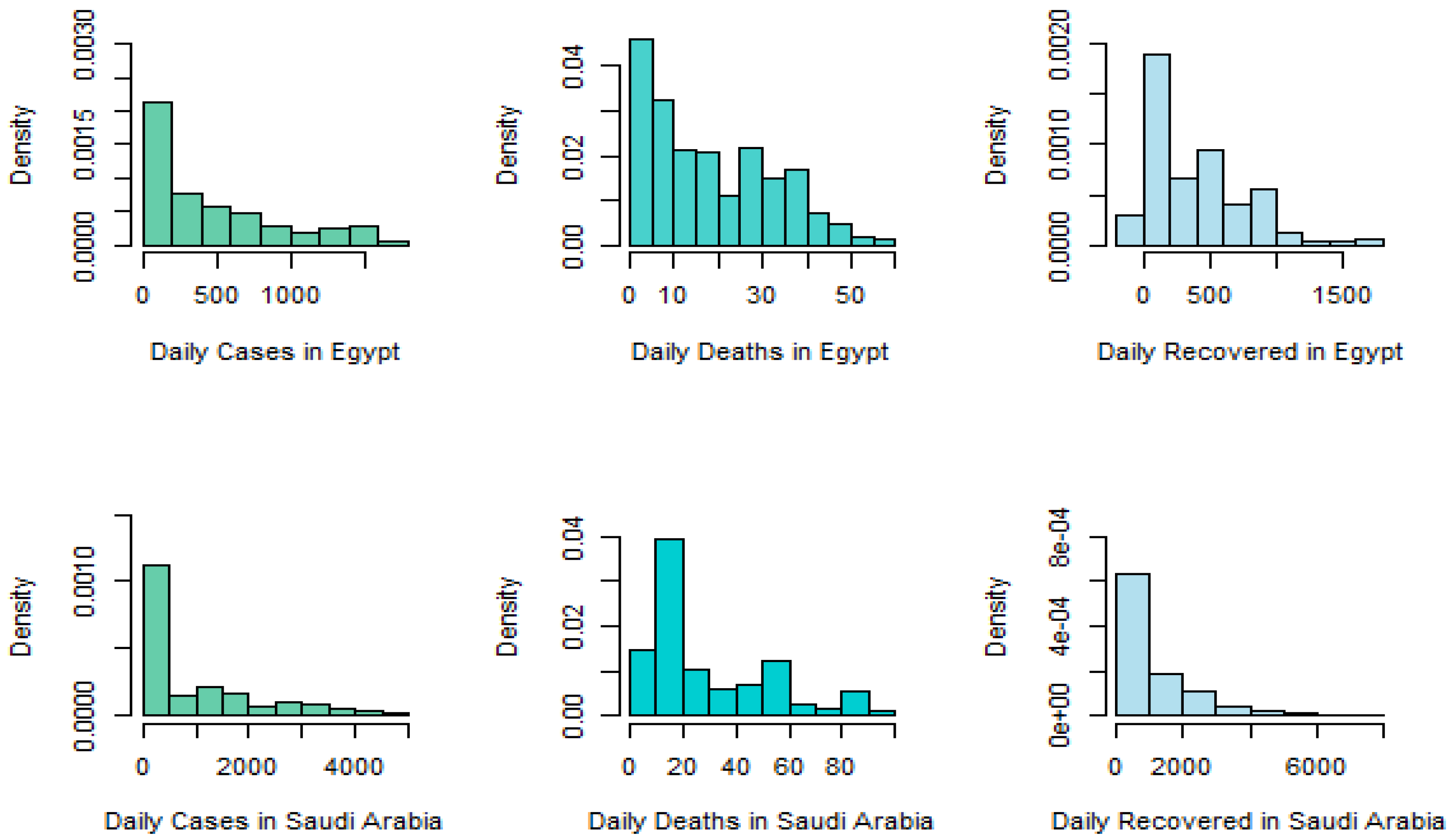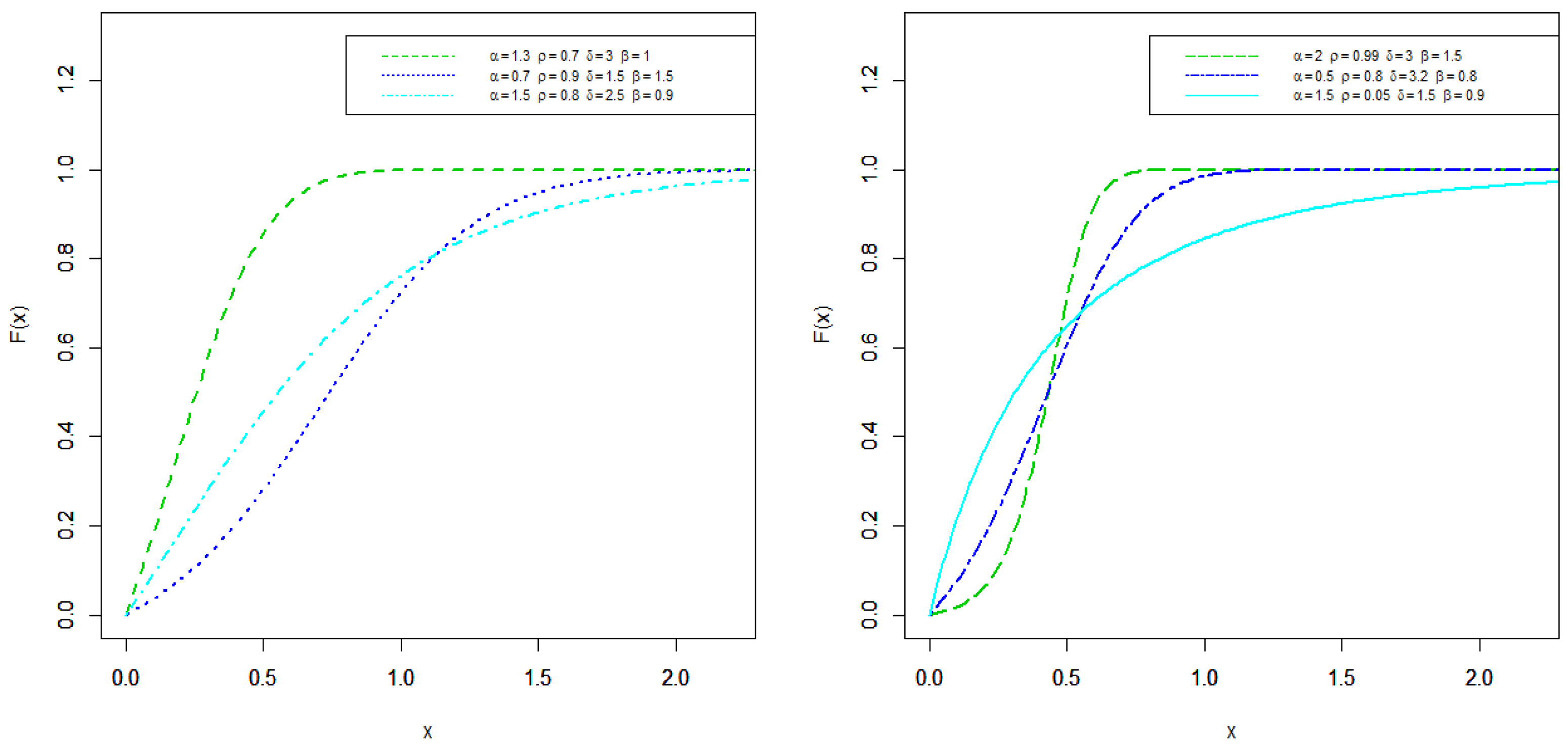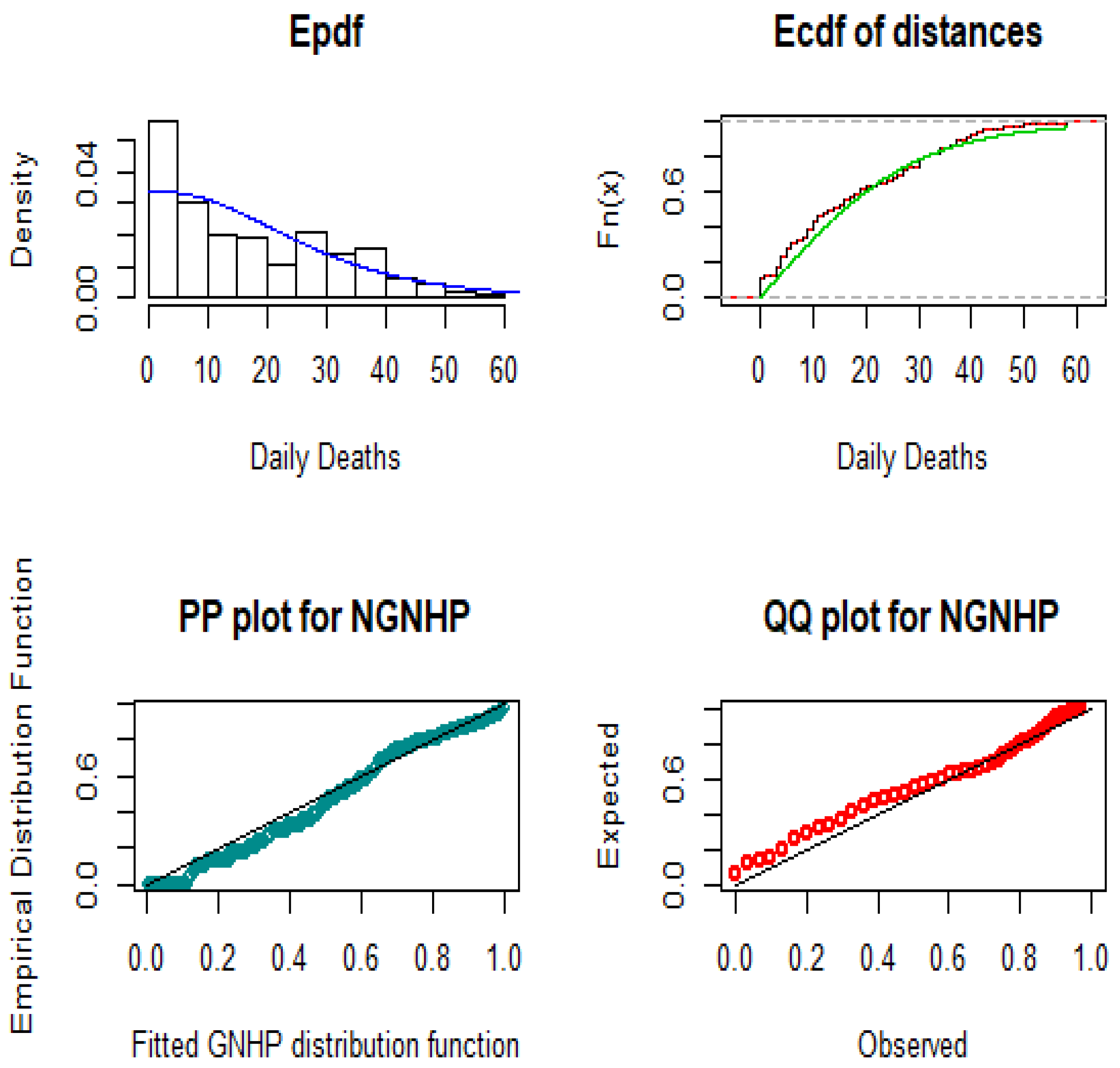Modeling the COVID-19 Pandemic Dynamics in Egypt and Saudi Arabia
Abstract
1. Introduction
2. Proposed Family
3. Maximum Likelihood Estimation
4. A Special Sub Model
5. Statistical Properties
5.1. Expansion for the NGNHP Density Function
5.2. Moments
6. Modeling COVID-19 Daily Cases and Daily Deaths in Egypt and Saudi Arabia
7. Concluding Remarks
Author Contributions
Funding
Data Availability Statement
Conflicts of Interest
References
- Nesteruk, I. Comparison of the coronavirus pandemic dynamics in Europe, USA and South Korea. medRxiv 2020. [Google Scholar] [CrossRef]
- Nesteruk, I. Comparison of the coronavirus epidemic dynamics in Italy and mainland China. In Investigation of Dynamics of Coronavirus Spreading; ResearchGate: Berlin, Germany, 2020. [Google Scholar] [CrossRef]
- Nesteruk, I. Comparison of the coronavirus pandemic dynamics in Ukraine and neighboring countries. In Investigation of Dynamics of Coronavirus Spreading; ResearchGate: Berlin, Germany, 2020. [Google Scholar] [CrossRef]
- Zhao, J.; Ahmad, Z.; Almaspoor, Z.; El-Morshedy, M.; Afify, A.Z. Modeling COVID-9 Pandemic Dynamics in Two Asian Countries. Comput. Mater. Contin. 2021, 67, 965–977. [Google Scholar] [CrossRef]
- Zheng, Q.; Wang, X.; Bao, C.; Ma, Z.; Pan, Q. Mathematical modelling and projecting the second wave of COVID-19 pandemic in Europe. J. Epidemiol. Commun. Health 2021. [Google Scholar] [CrossRef]
- Giordano, G.; Blanchini, F.; Bruno, R.; Colaneri, P.; Di Filippo, A.; Di Matteo, A.; Colaneri, M. Modelling the COVID-19 epidemic and implementation of population-wide interventions in Italy. Nat. Med. 2020, 26, 855–860. [Google Scholar] [CrossRef]
- Anastassopoulou, C.; Russo, L.; Tsakris, A.; Siettos, C. Data-based analysis, modelling and forecasting of the COVID-19 outbreak. PLoS ONE 2020, 15, e0230405. [Google Scholar] [CrossRef]
- Naik, P.A.; Yavuz, M.; Qureshi, S.; Zu, J.; Townley, S. Modeling and analysis of COVID-19 epidemics with treatment in fractional derivatives using real data from Pakistan. Eur. Phys. J. Plus 2020, 135, 1–42. [Google Scholar] [CrossRef] [PubMed]
- Musa, S.S.; Qureshi, S.; Zhao, S.; Yusuf, A.; Mustapha, U.T.; He, D. Mathematical modeling of COVID-19 epidemic with effect of awareness programs. Infect. Dis. Model. 2021, 6, 448–460. [Google Scholar] [CrossRef] [PubMed]
- Alghamdi, M.; AlQarni, M.S.; Alshomrani, A.S.; Ullah, M.Z.; Baleanu, D. Dynamics of COVID-19 via singular and non-singular fractional operators under real statistical observations. Math. Methods Appl. Sci. 2020. [Google Scholar] [CrossRef]
- Langemann, D.; Nesteruk, I.; Prestin, J. Comparison of mathematical models for the dynamics of the Chernivtsi children disease. Math. Comput. Simul. 2016, 123, 68–79. [Google Scholar] [CrossRef]
- La Gatta, V.; Moscato, V.; Postiglione, M.; Sperli, G. An Epidemiological Neural network exploiting Dynamic Graph Structured Data applied to the COVID-19 outbreak. IEEE Trans. Big Data 2021, 7, 45–55. [Google Scholar] [CrossRef]
- Nadler, P.; Arcucci, R.; Guo, Y. A Neural SIR Model for Global Forecasting. Mach. Learn. Res. 2020, 136, 254–266. [Google Scholar]
- Alzaatreh, A.; Lee, C.; Famoye, F. A new method for generating families of continuous distributions. Metron 2013, 71, 63–79. [Google Scholar] [CrossRef]
- Al-Babtain, A.A.; Shakhatreh, M.K.; Nassar, M.; Afify, A.Z. A New Modified Kies Family: Properties, Estimation Under Complete and Type-II Censored Samples, and Engineering Applications. Mathematics 2020, 8, 1345. [Google Scholar] [CrossRef]
- Jayakumar, K.; Mathew, T. On a generalization to Marshall–Olkin scheme and its application to Burr type XII distribution. Stat. Pap. 2008, 49, 421–439. [Google Scholar] [CrossRef]
- Cordeiro, G.M.; Alizadeh, M.; Silva, R.B.; Ramires, T.G. A New Wider Family of Continuous Models: The Extended Cordeiro and de Castro Family. Hacet. J. Math. Stat. 2016, 47, 25. [Google Scholar] [CrossRef]
- Oluyede, B.O.; Warahena-Liyanage, G.; Pararai, M. A new compound class of log-logistic Weibull–Poisson distribution: Model, properties and applications. J. Stat. Comput. Simul. 2015, 86, 1363–1391. [Google Scholar] [CrossRef]
- Mansour, M.M.; Mohamed, S.M. A new generalized of transmuted Lindley distribution. Appl. Math. Sci. 2015, 9, 2729–2748. [Google Scholar] [CrossRef]
- Maurya, S.K.; Kaushik, A.; Singh, R.K.; Singh, S.K.; Singh, U. A new method of proposing distribution and its application to real data. Imp. J. Interdiscip. Res. 2016, 2, 1331–1338. [Google Scholar]
- Abouammoh, A.; Kayid, M. A New Family of Extended Lindley Models: Properties, Estimation and Applications. Mathematics 2020, 8, 2146. [Google Scholar] [CrossRef]
- Chen, Z. A new two-parameter lifetime distribution with bathtub shape or increasing failure rate function. Stat. Probab. Lett. 2000, 49, 155–161. [Google Scholar] [CrossRef]
- Mansour, M.M.; Ibrahim, M.; Aidi, K.; Butt, N.S.; Ali, M.M.; Yousof, H.M.; Hamed, M.S. A New Log-Logistic Lifetime Model with Mathematical Properties, Copula, Modified Goodness-of-Fit test for Validation and Real Data Modeling. Mathematics 2020, 8, 1508. [Google Scholar] [CrossRef]
- Tahir, M.H.; Hussain, M.A.; Cordeiro, G.M. A new flexible generalized family for constructing many families of distributions. J. Appl. Stat. 2021, 1–21. [Google Scholar] [CrossRef]
- Maurya, S.K.; Nadarajah, S. Poisson Generated Family of Distributions: A Review. Sankhya B 2020, 1–57. [Google Scholar] [CrossRef]
- Nadarajah, S.; Cancho, V.G.; Ortega, E.M.M. The geometric exponential Poisson distribution. J. Ital. Stat. Soc. 2013, 22, 355–380. [Google Scholar] [CrossRef]
- Nadarajah, S.; Haghighi, F. An extension of the exponential distribution. Statistics 2011, 45, 543–558. [Google Scholar] [CrossRef]









| Estimates of the MLEs of the Parameters | ||||
|---|---|---|---|---|
| Data | ||||
| Egyptian COVID-19’s daily cases data | 0.1461 | 0.9990 | 7632 | 0.1413 |
| Saudi COVID-19’s daily cases data | 0.0509 | 0.9985 | 7286 | 0.1327 |
| Egyptian COVID-19’s daily deaths data | 2.3845 | 0.6525 | 0.0106 | 2.2230 |
| Saudi COVID-19’s daily deaths data | 0.1576 | 0.5715 | 0.0715 | 1.009 |
| AIC | CAIC | BIC | |
|---|---|---|---|
| Egyptian COVID-19’s daily cases data | 5094.923 | 5095.011 | 5110.566 |
| Saudi COVID-19’s daily cases data | 5560.234 | 5560.322 | 5575.877 |
| Egyptian COVID-19’s daily deaths data | 2976.485 | 2976.573 | 2992.129 |
| Saudi COVID-19’s daily deaths data | 2840.788 | 2840.876 | 2856.431 |
Publisher’s Note: MDPI stays neutral with regard to jurisdictional claims in published maps and institutional affiliations. |
© 2021 by the authors. Licensee MDPI, Basel, Switzerland. This article is an open access article distributed under the terms and conditions of the Creative Commons Attribution (CC BY) license (https://creativecommons.org/licenses/by/4.0/).
Share and Cite
Mansour, M.M.; A. Farsi, M.; Mohamed, S.M.; Abd Elrazik, E.M. Modeling the COVID-19 Pandemic Dynamics in Egypt and Saudi Arabia. Mathematics 2021, 9, 827. https://doi.org/10.3390/math9080827
Mansour MM, A. Farsi M, Mohamed SM, Abd Elrazik EM. Modeling the COVID-19 Pandemic Dynamics in Egypt and Saudi Arabia. Mathematics. 2021; 9(8):827. https://doi.org/10.3390/math9080827
Chicago/Turabian StyleMansour, Mahmoud M., Mohammed A. Farsi, Salah M. Mohamed, and Enayat M. Abd Elrazik. 2021. "Modeling the COVID-19 Pandemic Dynamics in Egypt and Saudi Arabia" Mathematics 9, no. 8: 827. https://doi.org/10.3390/math9080827
APA StyleMansour, M. M., A. Farsi, M., Mohamed, S. M., & Abd Elrazik, E. M. (2021). Modeling the COVID-19 Pandemic Dynamics in Egypt and Saudi Arabia. Mathematics, 9(8), 827. https://doi.org/10.3390/math9080827






